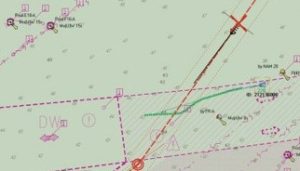The Charity
Aviation
Maritime
Non-Compliance with the collision regulations in North Sea Deep Water Route

Initial Report
Report text:
We are loaded tanker Length 242m breadth 44m, draft 15m bound from Skagen to Rotterdam. Due to dense fog we proceed at 11.2 kts. From the East there is in traffic lane approaching vessel “A” on a collision course. Our heading 220 and their heading is about 260. Collision is imminent and we called them ask to go astern of as per Collision Rules. They refuse and tell that it’s too late for them! They tell us that they will go ahead of us, crossing our bow. We can easily see that it is not possible as they have only 8.7 kts speed. Our only possibility is stop engine and let the speed go down. Finally they changed their course more to port as observed from the radar track plotting pictures. If we had not stopped our engine, they never would have passed our bow. We had three radars plotting continuously their manoeuvres and situation was critical all the time and that’s why we decided to ask what they are going to do. Our speed was only about 5kts when they finally passed our bow.

Lessons learned by the reporter: It has been clear to me for some time that professionalism on ships bridges is lower than ever. Since STCW came in force we have seen worse and worse quality people working on ship bridges. Many pilots see exhausted Masters who have been on bridges for days, as they can’t let the Mates to be there alone. It’s unbelievable how people vary with the same license from the same training requirements in schools. Almost every day we see and meet ships where people do not even know the ‘Rules of the Road’ or even basic seamanship skills. IMO with Government authorities should exercise controls on how these licenses are issued. What have we learnt from this? One must be extremely careful, as most probably there are people with a very poor knowledge of navigation on the other bridge and to keep well clear all of other vessels.
We see these things more and more every day and there is no end in this process unless somebody does something about it. Now in the ECDIS world, the game is going to get even worse. I don’t feel good to see this. It would be nice to hear other colleague’s comments.
CHIRP contacted the ship owner of ship “A”. They replied with a report from their ship’s officer of the watch (OOW) who confirmed the time and position as per the reporter’s statement. The OOW observed the reporter’s ship to be making a speed of 9.6 knots with ARPA plot showing an opening bearing to his starboard side with CPA 1.0 miles. The OOW claims his course was 263 and speed 8.7-8.9 knots and saw the ship abeam at 3-4 Miles distance, not in thick fog as claimed by the reporter. The OOW also did not hear any fog signals. He called the reporter’s ship and told him of his intentions to alter course to port to increase the CPA to 1.5 miles. The reporter asked that he pass astern but the OOW replied it was too late to undertake that manoeuvre. The reporter’s claim to have stopped his ship was not observed. The OOW on ship “A” concludes he believes in such situations, altering course and good cooperation is more effective to avoid risk of collision, especially in good visibility and not dense fog. Also there was sufficient sea room with no closer vessel at that time.
CHIRP Comment
At a previous Maritime Advisory Board (MAB) meeting, a comment was made that exercises on the ship simulator, show that navigators are sometimes reluctant to make a large alteration to starboard to keep clear of a vessel on or near to their starboard beam. This appears to be such a case. It might also be that, as Vessel “A” was close to the Northern edge of the Deepwater Route, the OOW may have been reluctant, perhaps unnecessarily, to go outside it.
The MAB reviewed the statements from both ships and they noted a number of inconsistencies between the reports from each ship, most notably one ship claims to be in dense fog and the other having clear visibility. However the statement from the OOW on the Ship ‘A’ reveals he saw red lights on his starboard side and therefore he was the crossing vessel and should have taken early avoiding action.
The reporter’s list of lessons learned was not supported, as these appear to be opinionated and not directly related to the actual event. The Board expressed concern over the level of competence in the officer’s understanding and application of the Collision Regulations.
CHIRP has replied to the operators of the Ship ‘A’ and advised them that based on the evidence they provided; the Board is of the opinion:
• The Officer of the watch (OOW) should have complied with the Collision Regulations and taken early and decisive action;
• OOW should have called the Master when the close quarter’s situation appeared to be imminent;
• The company should undertake OOW training in order to improve the level of understanding of the Collision Regulations, and
• The company should consider the adequacy of their auditing of Bridge operations.
CHIRP also replied to the Reporter and advised him of the Board’s appreciation of his report and relayed the opinion they have given to the cargo ship’s operators. In addition, the Board reminded the reporter of the need for early and decisive action, as the other ship may not have easily noticed the reduction in speed of the tanker. The Board has questioned whether the original speed of 11 knots in dense fog was appropriate.







